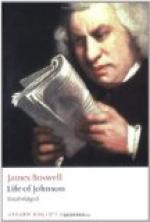We went and saw Colonel Nairne’s garden and grotto. Here was a fine old plane tree. Unluckily the colonel said, there was but this and another large tree in the county. This assertion was an excellent cue for Dr. Johnson, who laughed enormously, calling to me to hear it. He had expatiated to me on the nakedness of that part of Scotland which he had seen. His Journey has been violently abused, for what he has said upon this subject. But let it be considered, that, when Dr. Johnson talks of trees, he means trees of good size, such as he was accustomed to see in England; and of these there are certainly very few upon the eastern coast of Scotland. Besides, he said, that he meant to give only a map of the road; and let any traveller observe how many trees, which deserve the name, he can see from the road from Berwick to Aberdeen[210]. Had Dr. Johnson said, ‘there are no trees’ upon this line, he would have said what is colloquially true; because, by no trees, in common speech, we mean few. When he is particular in counting, he may be attacked. I know not how Colonel Nairne came to say there were but two large trees in the county of Fife. I did not perceive that he smiled. There are certainly not a great many; but I could have shewn him more than two at Balmuto, from whence my ancestors came, and which now belongs to a branch of my family[211].
The grotto was ingeniously constructed. In the front of it were petrified stocks of fir, plane, and some other tree. Dr. Johnson said, ’Scotland has no right to boast of this grotto; it is owing to personal merit. I never denied personal merit to many of you.’ Professor Shaw said to me, as we walked, ’This is a wonderful man; he is master of every subject he handles.’ Dr. Watson allowed him a very strong understanding, but wondered at his total inattention to established manners, as he came from London.
I have not preserved in my Journal, any of the conversation which passed between Dr. Johnson and Professor Shaw; but I recollect Dr. Johnson said to me afterwards, ‘I took much to Shaw.’
We left St. Andrews about noon, and some miles from it observing, at Leuchars, a church with an old tower, we stopped to look at it. The manse, as the parsonage-house is called in Scotland, was close by. I waited on the minister, mentioned our names, and begged he would tell us what he knew about it. He was a very civil old man; but could only inform us, that it was supposed to have stood eight hundred years. He told us, there was a colony of Danes in his parish[212]; that they had landed at a remote period of time, and still remained a distinct people. Dr. Johnson shrewdly inquired whether they had brought women with them. We were not satisfied as to this colony.




